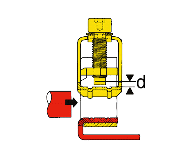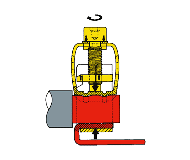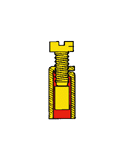Electrical and Instrument Wiring Terminal Connections
The following is from Weidmüller Pty Ltd
Modular terminals are available with many different types of connection - The principles of some of these are detailed below;
Spring Connection
|
|
The Weidmüller tension clamp system functions in a similar way to the proven clamping yoke. Separation between the mechanical and electrical functions has also been maintained with the tension spring version. The tension clamp made of high-quality, non-rusting and acid-resistant steel draws the conductor towards the electroplated copper current bar. Minimal contact resistance and high corrosion resistance is achieved by the tinlead plated surface and permanently maintained by the compensating action of the tension clamp. |
Solder Connection
|
|
The solder connection is still important in certain areas of electrical engineering. Conductors up to max. 2.5 mm 2 are directly soldered to solder lugs or solder brakets. Soldering guarantees a good electrical connection, the prerequisite being that this work is correctly performed. |
Spring-clip connection
|
|
The spring-clip connection is a solderless electrical connection (DIN 41611, Part 4). The connection is chieved by a pneuma-tic gun. The spring-clip and the conductor are simultaneously shot onto a pin with rectangular or square cross-section. The method is suitable for both solid and stranded conductors up to max. 0.5 mm² (AWG 20). The tool (gun) and spring-clips are available from AMP Deutschland, D-63225 Langen. |
Pressure Clamp Connection
|
|
With the patented pressure clamp connection system, Weidmüller has developed a screw connection system for large conductors. The often difficult insertion of large conductors into the clamp is facilitated by easy removal of the crew unit form the terminal. The conductor is then placed directly on the current bar, the screw unit inserted and the conductor clamped tight. |
|
| Principle of vibration resistance
On account of the difference in length d between the shank of the clamping screw and the resilient pressure clamp, the pressure clamp deforms elestically when the screw is tightened. The high spring force of the pressure clamp produces the vibration resistance and compensates for any movement of the connected conductor. Retightening of the clamping screw is, therefore, unnecessary. |
|
Top Connection
 |
The TOP connection system from Weidmüller fulfils the requirement that insertion of the conductor and actuation of the screw occur in one direction. This brings wiring advantages under certain assembly conditions, e.g. with small lateral spacing in component containers. The TOP connection system combines the special properties of steel and copper. The conductor is pressed directly against the copper of brass current bar by a hardened steel pressure yoke. The high contact force guarantees a gastight connection between conductor and |
|
| Principle of vibration resistance The force exerted by the steel pressure clamp when the screw is tightened pulls the two halves of the TOP connection apart, as with the clamping yoke. This exerts a locking action on the screw and provides excellent vibration resistance. |












